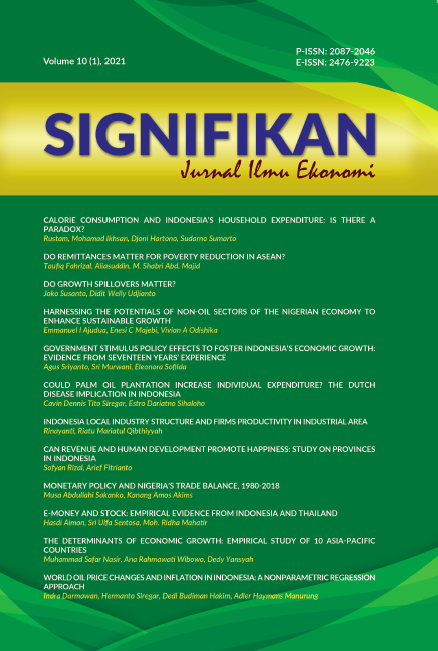Monetary Policy and Nigeria's Trade Balance, 1980-2018
DOI:
https://doi.org/10.15408/sjie.v10i1.18132Keywords:
autoregressive distributed lag, monetary policy, trade balanceAbstract
Several countries have integrated monetary easement into their foreign policy to faucet the gains from trade thereby, assuring that market forces determine monetary policy instruments such as interest rate and exchange rate. It is on this note and this paper empirically evaluate the effect of monetary policy on Nigeria's trade balance using the Autoregressive Distributed Lag Model on the time series data spanning from 1980 to 2018. The findings reveal that monetary policy tools of real interest and effective exchange rate have a long-run co-integration relationship and significant adverse effects on Nigeria's trade balance both in the short-run and long-run. Thus, the paper concludes that monetary policy is a veritable tool through which Nigeria can maintain a favorable trade balance. Therefore, policymakers should step on measures that will maintain low-interest rates to sustain a flexible exchange rate and remove all rigidities associated with the international payment system.
JEL Classification: C22, E52, F13
How to Cite:
Sakanko, M. A., & Akims, K. A. (2021). Monetary Policy and Nigeria’s Trade Balance, 1980-2018. Signifikan: Jurnal Ilmu Ekonomi, 10(1), 129-138. https://doi.org/10.15408/sjie.v10i1.18132.
References
Adamu, P. A., & Itsede, O.C. (2014). Balance of Payments Adjustment: West African Monetary Zone Experience. Journal of Monetary and Economic Integration, 10(2), 100-116.
Adeyemi, O. J., & Ajibola, A. (2019). Naira Devaluation and Trade Balance in Nigeria. World Scientific News, 125, 181-192.
Aftab, Z., & Aurangzeb. (2002). The Long-run and Short-run Impact of Exchange Rate Devaluation on Pakistan’s Trade Performance. Pakistan Development Review, 41(3), 277–286.
Ajie, A. H., & Nenbee, S.G. (2010). Monetary Policy and Balance of Payments in Nigeria, 1970 -2009. African Journal of Humanities and Society, 4(2), 171-198.
Bonga-Bonga, L. (2017). Fiscal Policy, Monetary Policy, and External Imbalances: Cross-Country Evidence from Africa's Three Largest Economies (Nigeria, South Africa, and Egypt). Munich Personal RePEc Archive (MPRA) Paper No. 79490.
Costamagna, R. (2014). Competitive Devaluations and The Trade Balance in Less Developed Countries : An Empirical Study of Latin American Countries. Economic Analysis and Policy, 44(3), 266–278.
Danmola, R. A., & Olateju, A. O. (2013). The Impact of Monetary Policy on The Current Account Balance in Nigeria. Journal of Humanities and Social Science, 7(3), 67-72.
Enoma, A., & Itsedu, M. (2011). The Impact of Financial Sector Reforms on Non-Oil Export in Nigeria. Journal of Economics, 2(2), 115-120.
Fasanya, I. O., Onakoya, A. B., & Agboluaje, M. A. (2013). Does Monetary Policy Influence Economic Growth in Nigeria. Asian Economic and Financial Review, 3(5), 635-646.
Fleming, J. M. (1962). Domestic Financial Policies under Fixed and Floating Exchange Rates. International Monetary Fund Staff Papers, 9, 369 – 379.
Haile, M. A. (2017). Does Trade Openness Reduce Inflation? Empirical Evidence from Ethiopia. Global Journal of Management and Business Research: Economics and Commerce, 17(1), 239-249.
Imoughele, L. E., & Ismaila, M. (2015). Monetary Policy and Balance of Payments Stability in Nigeria. International Journal of Academic Research in Public Policy and Governance, 2(1), 1-15.
Michael, E. O., & Emeka, A. (2017). An Empirical Study of the Effect of Monetary Policy Variables on Net Export of Nigeria. IOSR Journal of Economics and Finance, 8(5), 71-82. DOI: 10.9790/5933-0805037182
Mundell, R. A. (1963). Capital Mobility and Stabilization Policy under Fixed and Flexible Exchange Rates. Canadian Journal of Economics and Political Science, 29(4), 475 – 485.
Ncube, M., & Ndou, E. (2013). Monetary Policy and Exchange Rate Shocks on South African. Trade Balance. African Development Bank Group Working Paper Series No. 169.
Nizamani, A., Karim, A. Z., Zaidi, M. A. S., & Khalid, N. (2016). Trade Balance Response to Shocks in Monetary Policy and Exchange Rate: Evidence from Pakistan. International Journal of Business and Society, 18(3), 579-594.
Oluyemi, O., & Isaac, E. D. (2017). The Effect of Exchange Rate on Imports and Exports in Nigeria, 1996 - 2015. International Journal of Economics and Business Management, 3(2), 66 – 77.
Onuchuku, O., Chukueggu, C.C., Nenbee, S.G. & Wosu, C. (2018). Monetary Policy and Nigeria’s Balance of Payments. Proceedings of ISER 128th International Conference, New York, USA, 16th-17th May 2018.
Pesaran, M. H., Shin, Y., & Smith, R. J. (2001). Bounds Testing Approaches to the Analysis of Level Relationships. Journal of Applied Econometrics, 16(3), 289-326. https://doi.org/10.1002/jae.616
Ramzan., Kalsoom, F., & Zareen, Y. (2013) An Analysis of the Relationship Between Inflation and Trade Opennes. Interdisciplinary Journal of Contemporary Research in Business, 5(3), 215-229.
Sakanko, M. A., & David, J. (2017). An Econometric Analysis of the Determinants of Exchange Rate in Nigeria (1980 - 2016). European Journal of Business and Management, 9(34), 22-29.
Sakanko, M. A., Obilikwu, J., & David, J. (2019). Oil Price Volatility and Balance of Payments (BOP): Evidence of Nigeria. Bingham Journal of Economics and Allied Studies, 2(3), 69-82.
Sakanko, M. A., & David, J. (2019). Trade Openness and Inflation: Empirical Explanation of the Nexus in Nigeria. International Journal of Social Science and Economic Review, 1(2), 35-45. https://doi.org/10.9116/ijsser.2019.1.1.05.

